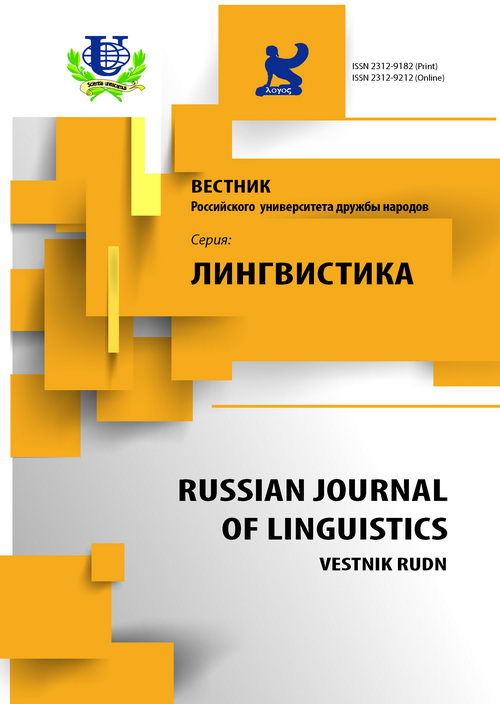The World beyond the Words: An Axiological Comparative Study of Zoonyms of Russian and Hindi
- Authors: Uma Parihar -1
-
Affiliations:
- Vikram University University road
- Issue: No 3 (2015)
- Pages: 54-71
- Section: Articles
- URL: https://journals.rudn.ru/linguistics/article/view/9426
Cite item
Full Text
Abstract
Mankind and the animal kingdom enjoyed a close and interwoven relationship ever since they appeared on earth. This camaraderie found its reflection in language too. That is why the words that name animals have a lot more in their undertones along with the explicit meanings. This article is an endeavor to peep into the world beyond the zoonyms of Russian and Hindi. The comparative study reveals various kinds of connotations that these zoonyms hold for us. These inferences are positive, semi positive and at times, even negative. Some are similar in both the languages, the others are contrasting. Animals are a vital part of Indian mythology. They serve as riders ( vahana ) to deities. Hence Indians have a respectful attitude towards them, even when they may not like a specific behavioral trait of a particular animal. The data for the analyses taken from dictionaries, fiction and spoken language. It was analised through definitive, contextual, pragmatic, cognitive and linguocutural analyses.
About the authors
- Uma Parihar
Vikram University University road
Email: umaparihar@yahoo.com
Department of Foreign Languages
References
- Ларина Т.В. Категория вежливости и стиль коммуникации. Сопоставление английских и русских лингвокультурных традиций. М.: Языки славянских культур, 2009.
- Kluckhohn F.R. and Strodtbeck F.L. Variations in Value Orientations. Chicago: Row, Peterson, 1961.
- Wierzbicka Anna. Understanding cultures through their key words: English, Russian, Polish and Japanese. N.Y.; London: Oxford University Press, 1997.
- Зализняк А.А., Левонтина И.Б., Шмелев А.Д. Ключевые идеи русской языковой картины мира: Сб. ст. М.: Языки славянской культуры, 2005. С. 307-335.
- Гладкова А. Русская культурная семантика. Эмоции, ценности, жизненные установки. М.: Языки славянских культур, 2010.
- Чэнь Сянхой Сопоставительный анализ национально-культурной коннотации китайских и русских зоонимов. Диссертация на соискание ученой степени магистра филологических наук. Факультет русского языка шанхайского университета иностранных языков. Декабрь 2007 года. Link: http://202.121.96.135:8086/openfile?dbid=72&objid=18609&flag=free.
- Сакаева Л.Р. Фразеологизмы с компонентами зоонимами, описывающие человека как объект сопоставительного анализа русского и английского языков. In the journal: Известия Российского государственного педагогического университета им. А.И. Герцена. 2008. Вып. № 62 / Link: http://cyberleninka.ru/article/n/frazeologizmy-s-komponentami-zoonimami-opisyvayuschie-cheloveka-kak-obekt-sopostavitelnogo-analiza-russkogo-i-angliyskogo-yazykov.
- Соколова А.Г. Кошка и Собака в русском и немецком языках (на материале толковых и фразеологических словарей). Link: http://www.narfu.ru/sf/sevgi//departments/rus/science/ conf/sokolova.pdf.
- Гишкаева Л.Н. Влияние «кастильского испанского» на формирование фразеологического состава (с зоо- и фитокомпонентами) мексиканского национального варианта испанского языка. In the Journal: Вестник Российского университета дружбы народов. Серия «Лингвистика». 2014. № 3. P. 120.
- Трубачев О.Н. Происхождение названий домашних животных в славянских языках (Этимологические исследования). М., 1960.
- Большой фразеологический словарь русского языка. Значение. Употребление. Культурологический комментарий / Отв. ред. В.Н. Телия. М., 2006 [БФСРЯ].
- Гутман Е.А., Литвин Ф.А., Черемисина М.И. Сопоставительный анализ зооморфных характеристик // Национально-культурная специфика речевого поведения. М., 1977. P. 40-54.
- Рыжкина О.А. Системное исследование зооморфизмов в русском языке. М., 1980.
- Миронюк Л.Ф. Семантическая типология славянских зооморфических глаголов. Днепропетровск, 1987.
- Сюсько М.И. Способы и типы деривации в зоонимии: Учебное пособие. Киев, 1989.
- Огдонова Ц.Ц. Зооморфная лексика как фрагмент русской языковой картины мира. Дисс.. канд. филол. наук. Иркутск, 2000.
- Кимягарова Р.С. Словарь языка басен Крылова. М., 2006.
- Oxford Advanced Learners Dictionary. Link: http://www.oxfordlearnersdictionaries.com/ definition/english/cow_1? q=cow.
- Krylov Ivan A. Fables. Link: http://rvb.ru/18vek/krylov/01text/vol3/01fables/085.htm.
- Akhmatova A. “Requiem” in Russian. Link: http://www.stihi-rus.ru/1/Ahmatova/142.htm.
- Akhmatova A. “Requiem” in English translation. Link: http://www.poetryintranslation.com/ PITBR/Russian/Akhmatova. htm#_Toc322442229.
- Пик сталинских репрессий - История России. Link: histrf.ru/ru/lenta-vremeni/../pik-stalinskikh-riepriessii.
- Фразеологизмы. Слон. Link: http://wordsland.ru/zs/dolina/index.php?s=14.
- Словарь Ушакова Д.Н. Link: http://dic.academic.ru/contents.nsf/ushakov.
- Vanara. Link: http://en.wikipedia.org/wiki/Vanara.
- Словарь символов. Link: http://enc-dic.com/ozhegov/CHerepaha-38959.html.
- Ожегов С.И. Словарь русского языка. М.: Советская энциклопедия, 1973. Online link: http://enc-dic.com/ozhegov/Korova-13132.html.
- Ожегов С.И., Шведова Н.Ю. Толковый словарь русского языка. 80 000 слов и фразеологических выражений. М., 1999 [СОШ].
- Panchatantra. Short stories. Link: www.talesofpanchatantra.com/panchatantra_shortstories_ kids.php.
- Owl. Link: http://en.wikipedia.org/wiki/Owl.
- Corvus (genus) Link: http://en.wikipedia.org/wiki/Corvus_%28genus%29.
- Holy Cows. Lonk: http://www.religionfacts.com/hinduism/beliefs/cow.
- Monkey. Link: http://en.wikipedia.org/wiki/Monkey.
- Tortoise. Link: http://en.wikipedia.org/wiki/Tortoise.
- Hinduism. Link: http://en.wikipedia.org/wiki/Hinduism.
- Tortoise Is Important In Both Vastu Shastra And In Feng Shui. Link: http://en.wikipedia.org/ wiki/Hinduism.
- The monkey and the crocodile (बंदर और मगरमच्छ). Link: http://stories4little1.blogspot.in/ 2012/02/monkey-and-crocodile-bandar-aur.html.
- हिन्दी - रूसी शब्दकोष (दो खंडो में) "सोवेत्सकया एनत्सिकलोपेदिया" प्रकाशन गृह, मास्को, 1973.
- आचार्य कमल नंदलाल. घर में कछुआ रखने के क्या हैं लाभ. Punjab Kesari E-Paper. Wednesday, September 10, 2014 Link: http://www.punjabkesari.in/news/article-283077.
- भारतीय संस्कृति का प्रतीक हाथी. Link: http://hi.bharatdiscovery.org/india/%E0%A4% B9%E0%A4%BE%E0%A4%A5%E0%A5%80
- कौआ. Link: http://hi.bharatdiscovery.org/india/%E0%A4%95%E0%A5%8C%E0%A4%86.
- हिन्दू देवी-देवता. Link: http://hi.wikipedia.org/wiki/%E0%A4%B9%E0%A4%BF%E0% A4%A8%E0%A5%8D%E0%A4%A6%E0%A5%82_%E0%A4%A6%E0%A5%87%E0%A4%B5%E0%A5%80-%E0%A4%A6%E0%A5%87%E0%A4%B5%E0%A4%A4%E0%A4%BE.
- जानिए किस देवता का वाहन क्या है और क्यों है. Link: http://shitiksh.blogspot.in/ 2014/11/blog-post.html.
- Forest, Trees and Landscapes for Food Security and Nutrition: A Global Assessment Source: Sunday Hindustan Times. May 17 2015.

















